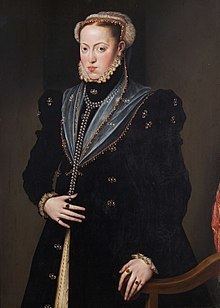Tenure 1562–1576 Mother Isabella of Portugal | Name Maria Austria, Role King | |
 | ||
Issue Anna, Queen of SpainRudolf II, Holy Roman EmperorErnest, Archduke of AustriaElisabeth, Queen of FranceMatthias, Holy Roman EmperorMaximilian III, Archduke of AustriaAlbert VII, Archduke of Austria Children Rudolf II, Holy Roman Emperor Parents Isabella of Portugal, Charles V, Holy Roman Emperor Siblings Philip II of Spain, Joanna of Austria, Princess of Portugal Similar People Charles V - Holy Roman E, Philip II of Spain, Maximilian II - Holy Roman E, Isabella of Portugal, Joanna of Austria - Princess | ||
Archduchess Maria of Austria (21 June 1528 – 26 February 1603) was Holy Roman Empress and queen consort of Bohemia and Hungary as the spouse of Maximilian II, Holy Roman Emperor and King of Bohemia and Hungary. She served as regent of Spain in the absence of her father Emperor Charles V from 1548 until 1551, and in the absence of her brother Philip II, from 1558 to 1561.
Contents
Life
Maria was born in Madrid to Charles V, Holy Roman Emperor and King of Spain, and Isabella of Portugal. She grew up mostly between Toledo and Valladolid with her siblings, Philip and Joanna. They built a strong family bond despite their father's regular absences. Maria and her brother, Philip, shared similar strong personal views and policies which they kept during the rest of their lives.
Married life
On 15 September 1548, aged twenty, she married her first cousin Archduke Maximilian. The couple had sixteen children during the course of a twenty-eight-year marriage.
While her father was occupied with German affairs, Maria and Maximilian acted as regents of Spain from 1548 to 1551 during the absence of Prince Philip. Maria stayed at the Spanish court until August 1551, and in 1552, the couple moved to live at the court of Maximilian's father in Vienna.
In 1558, Maria returned to Madrid and acted as regent of Spain during the absence of her brother, now King Philip II, from 1558 to 1561.
After her return to Germany, her husband gradually succeeded his father Ferdinand I as ruler of Germany, Bohemia and Hungary, which he ruled from 1564 to his death in 1576. Maria was a devout Catholic and frequently disagreed with her religiously ambiguous husband. She had great influence over her sons, the future emperors Rudolf and Matthias.
In 1576, Maximilian died. Maria remained at the imperial court for six years after his death.
Return to Spain
Maria returned to Spain in 1582, taking her youngest surviving child Margaret with her, promised to marry Philip II of Spain, who had lost his fourth wife Anna of Austria in 1580. Margaret finally refused and took the veil as a Poor Clare. Commenting that she was very happy to live in "a country without heretics", Maria settled in the Convent of Las Descalzas Reales in Madrid, where she lived until her death in 1603.
She was the patron of the noted Spanish composer Tomás Luis de Victoria, and the great Requiem Mass he wrote in 1603 for her funeral is considered among the finest and most refined of his works.
Maria exerted some influence together with Queen Margaret, the wife of Philip III of Spain. Margaret, the sister of the future Emperor Ferdinand II, would be one of three women at Philip's court who would apply considerable influence over the king. Margaret was considered by contemporaries to be extremely pious – in some cases, excessively pious, and too influenced by the Church, and 'astute and very skillful' in her political dealings, although 'melancholic' and unhappy over the influence of the Duke of Lerma over her husband at court. Margaret continued to fight an ongoing battle with Lerma for influence until her death in 1611. Philip had an 'affectionate, close relationship' with Margaret, and paid her additional attention after she bore him a son, also named Philip, in 1605.
Maria, the Austrian representative to the Spanish court – and Margaret of the Cross, Maria's daughter – along with queen Margaret, were a powerful Catholic and pro-Austrian faction in the court of Philip III of Spain. They were successful, for example, in convincing Philip to provide financial support to Ferdinand from 1600 onwards. Philip steadily acquired other religious advisors. Father Juan de Santa Maria, the confessor to Philip's daughter, Maria Anna, was felt by contemporaries to have an excessive influence over Philip at the end of his life, and both he and Luis de Aliaga, Philip's own confessor, were credited with the overthrow of Lerma in 1618. Similarly Mariana de San Jose, a favoured nun of Queen Margaret's, was also criticised for her later influence over the King's actions.
Children
Maria and Maximilian had sixteen children of which only five were still alive in the time of her death:
